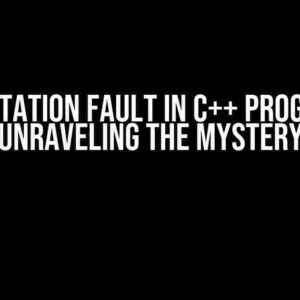Regex, or regular expressions, are a powerful tool for matching patterns in text. However, when it comes to replacing repeating regex, things can get a bit tricky. In this article, we’ll dive deep into the world of regex and explore the best ways to replace repeating regex patterns.
What is Repeating Regex?
Repeating regex refers to a pattern that appears multiple times in a sequence. For example, if we have a string “hellohellohello”, the pattern “hello” is repeating three times. In regex, we can use quantifiers to specify the number of times a pattern should be repeated.
hello{3}
The above regex pattern matches the string “hello” exactly three times. But what if we want to replace these repeating patterns with something else?
The Problem with Replacing Repeating Regex
When trying to replace repeating regex patterns, we often run into issues. The main problem is that regex engines tend to get confused when dealing with repeated patterns. This can lead to incorrect matches, missing matches, or even infinite loops.
For example, let’s say we want to replace the repeating pattern “hello” with “goodbye” in the string “hellohellohello”. A naive approach might look like this:
string.replace(/hello/g, "goodbye");
This might seem like it should work, but in reality, the regex engine will get stuck in an infinite loop, replacing the first “hello” with “goodbye”, and then replacing the resulting “goodbyehello” with “goodbye” again, and so on.
Solving the Problem with Grouping and Capturing
To avoid the infinite loop problem, we need to use grouping and capturing to mark the repeating pattern as a single unit. We can do this using parentheses to create a capture group.
string.replace(/(hello){3}/g, "goodbye");
In this example, we’re using parentheses to create a capture group around the pattern “hello”. The quantifier `{3}` specifies that the pattern should be repeated exactly three times. The `g` flag at the end tells the regex engine to search the entire string for matches.
By grouping and capturing the repeating pattern, we can ensure that the regex engine treats it as a single unit, rather than individual matches. This allows us to replace the entire repeating pattern with a single replacement string.
Using Capturing Groups to Replace Repeating Patterns
Capturing groups can also be used to replace repeating patterns with a custom replacement string. For example, let’s say we want to replace each “hello” with a incrementing number:
string.replace(/(hello)/g, (match, group) => `hello${++count}`);
In this example, we’re using a capture group to match the pattern “hello”. The replacement function takes two arguments: `match` (the entire match) and `group` (the captured group). We’re using the `group` argument to increment a counter variable and append it to the replacement string.
Using Lookaheads to Replace Repeating Patterns
Another approach to replacing repeating regex patterns is to use lookaheads. Lookaheads allow us to assert that a pattern matches without including it in the match.
string.replace(/hello(?=hello)/g, "goodbye");
In this example, we’re using a positive lookahead `(?=hello)` to assert that the pattern “hello” is followed by another “hello”. We’re not capturing the second “hello”, so the regex engine will only match the first occurrence.
By using lookaheads, we can ensure that the regex engine only matches the repeating pattern as a whole, rather than individual occurrences.
Using Negative Lookaheads to Replace Repeating Patterns
Negative lookaheads can also be used to replace repeating regex patterns. A negative lookahead asserts that a pattern does not match.
string.replace(/hello(?!hello)/g, "goodbye");
In this example, we’re using a negative lookahead `(?!hello)` to assert that the pattern “hello” is not followed by another “hello”. We’re only replacing the last occurrence of “hello” in the repeating pattern.
Real-World Examples of Replacing Repeating Regex
Now that we’ve covered the basics of replacing repeating regex patterns, let’s take a look at some real-world examples.
Replacing Consecutive Whitespace
A common use case for replacing repeating regex patterns is to remove consecutive whitespace characters.
string.replace(/\s+/g, " ");
In this example, we’re using the regex pattern `\s+` to match one or more whitespace characters. The `g` flag at the end tells the regex engine to search the entire string for matches.
Replacing Consecutive Duplicate Characters
Another common use case is to remove consecutive duplicate characters.
string.replace(/(.)\1+/g, "$1");
In this example, we’re using a capture group `(.)` to match any character. The `\1+` part of the pattern matches one or more occurrences of the same character. We’re replacing the entire match with the first captured group `$1`.
Conclusion
In this article, we’ve explored the world of replacing repeating regex patterns. We’ve covered the problems that can arise when trying to replace repeating patterns, and discussed the solutions using grouping and capturing, as well as lookaheads. We’ve also taken a look at some real-world examples of replacing repeating regex patterns.
By mastering the art of replacing repeating regex, you’ll be able to tackle even the most complex text processing tasks with ease. Whether you’re working with text manipulation, data processing, or parsing, regex is an essential tool to have in your arsenal.
| Regex Pattern | Description |
|---|---|
| (hello){3} | Matches the string “hello” exactly three times |
| (hello) | Captures the pattern “hello” as a single unit |
| hello(?=hello) | Asserts that the pattern “hello” is followed by another “hello” |
| hello(?!hello) | Asserts that the pattern “hello” is not followed by another “hello” |
| \s+ | Matches one or more whitespace characters |
| (.)\1+ | Matches consecutive duplicate characters |
Remember to practice and experiment with different regex patterns to become proficient in replacing repeating regex. Happy regexing!
- Regex101: A great online regex tester and debugger
- Regular-Expressions.info: A comprehensive regex tutorial and reference
- Stack Overflow: Regex Tag – A collection of regex-related questions and answers
- What is Repeating Regex?
- The Problem with Replacing Repeating Regex
- Solving the Problem with Grouping and Capturing
- Using Capturing Groups to Replace Repeating Patterns
- Using Lookaheads to Replace Repeating Patterns
- Real-World Examples of Replacing Repeating Regex
- Conclusion
Frequently Asked Question
Get ready to master the art of replacing repeating regex!
What is the purpose of replacing repeating regex?
Replacing repeating regex helps to simplify and optimize your regular expressions, making them more efficient and easier to maintain. It’s like decluttering your code, but for regex!
How do I identify repeating regex patterns?
Look for patterns that repeat in your regex, such as identical character classes or repeated sequences. You can also use tools like regex debuggers or visualizers to help you spot these patterns. Be on the lookout for opportunities to merge or simplify these repeated patterns!
What are some common techniques for replacing repeating regex?
Some popular techniques include using character classes, alternation, and grouping. You can also use regex features like possessive quantifiers, recursive patterns, and conditional expressions to simplify your regex. Get creative and experiment with different approaches to find the best solution for your specific use case!
Can replacing repeating regex improve performance?
Absolutely! By reducing the complexity of your regex, you can significantly improve performance. Fewer repeated patterns mean less work for the regex engine, resulting in faster matching and reduced CPU usage. Your users (and your servers) will thank you!
Are there any best practices for replacing repeating regex?
Yes! Always test your modified regex patterns thoroughly to ensure they still match your intended input. Use tools like regex testers and debuggers to verify the correctness and performance of your regex. And remember, simplicity and readability are key – aim for regex patterns that are easy to understand and maintain!


